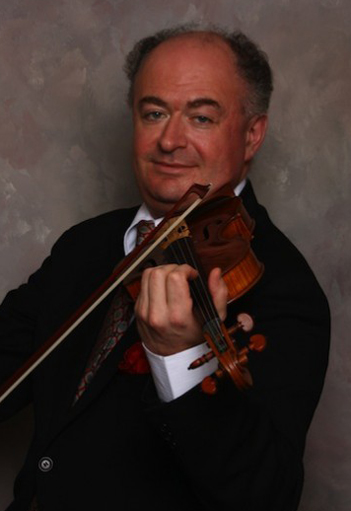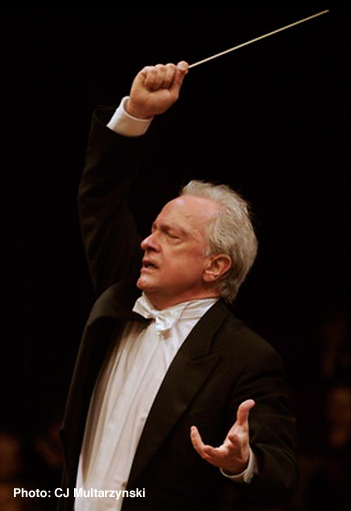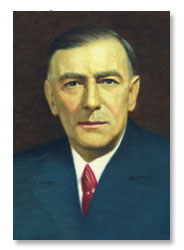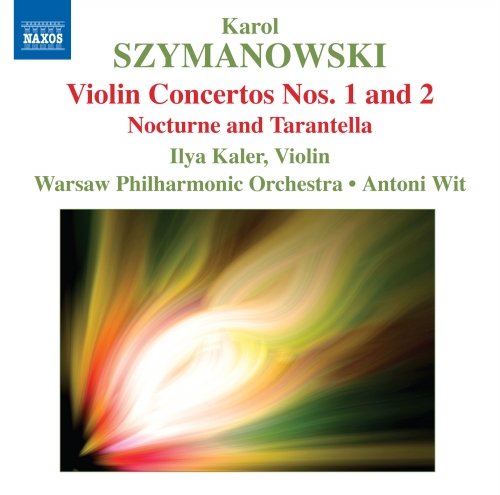SZYMANOWSKI: Violin Concertos Nos. 1 and 2 / Nocturne and Tarantella
Karol Szymanowski was born in the Ukraine into a wealthy artistic family. Following the Russian Revolution the family returned to their native Poland, where Szymanowski found inspiration in the indigenous music. His lyrical Violin Concerto No. 1 was dedicated to his great friend, the violinist Pavel Kochański, and is remarkable for its clarity of texture. Inspired by Kochański’s visit to Poland in 1932, the Violin Concerto No. 2 was written towards the end of Szymanowski’s creative life. The two musicians worked together on the score, which shows influences of the music of the Polish mountain people. The intense and virtuosic Nocturne and Tarantella draws on the Impressionism of Debussy and early Stravinsky but also on Middle Eastern culture and folklore.

Russian-born Ilya Kaler’s musical family encouraged him in his violin studies at an early age, his initial training being with Zinaida Gilels at the Moscow Conservatory’s Central Music School for Gifted Children. As did Sergey Stadler (his almost exact contemporary), Kaler took instruction from Leonid Kogan and Viktor Tretyakov at the conservatory, graduating with the Gold Medal Award. He also studied privately with Abram Shtern. One of his distinctions is to be the first violinist to win gold medals at the Paganini, Sibelius and Tchaikovsky Competitions.
His Paganini Caprices—his first recording for Naxos in 1992—were, according to the American Record Guide, ‘in a class by themselves’, combining ‘the perfection, passion, and phrase sculpting of Michael Rabin with the energy, excitement, and immediacy of Jascha Heifetz’. As might be expected, Kaler has performed with numerous world-class orchestras in Russia, Europe, America and Japan and has given solo recitals around the globe.
As a chamber musician, he has appeared at music festivals throughout the US and Europe. In the orchestral realm he has made guest-concertmaster appearances with the San Francisco Symphony, Philadelphia Orchestra, Baltimore Symphony and New York’s Rochester Philharmonic, as well as touring with the World Orchestra for Peace. Kaler has also held professorships at the Indiana University School of Music, Bloomington; the Eastman School of Music, Rochester; and the DePaul University School of Music, Chicago.
His recordings have been almost exclusively for Naxos. They reveal a powerful and charismatic interpreter, rather like Stadler, although in Kaler’s case the influence of his illustrious teachers is less apparent. His vibrato is full and rounded, without appearing excessive, his tone rich without being strident—although it can be steely and assertive, as found in the very accomplished Paganini Caprices, or Shostakovich’s ambivalent late-period Violin Concerto No. 2 (1996), which is given a colourful if not especially distinctive reading. His Tchaikovsky Concerto (2004) displays similar characteristics: it is a performance of some quality, but not of great character. Perhaps his most charismatic playing is found, interestingly for a soloist, in unaccompanied and duo sonata works. Thus, there is a fine 1993 performance of Schumann’s darkly heroic Op. 105 Violin Sonata, enlivened by some effective tempo flexibility (albeit unlike the types of nuance Schumann himself would have envisaged), and a soulful Ysaÿe Sonata No. 3 of 2001, which evidences a richer, wider vibrato than in some of his other recordings. Kaler’s unaccompanied Bach (2006), too, is free of some of the more conspicuous stylistic anachronisms that one might expect of ex-Soviet players: the G minor Sonata, BWV 1001 is thus played warmly and with a sensitively considered rather than monumental tonal approach. Glazunov’s Violin Concerto (1994) sees a much more fiery approach and is some of Kaler’s most committed playing on record, adding credence to The Washington Post’s praise of him as ‘a consummate musician, in total control at all times, with a peerless mastery of his violin’.
© Naxos Rights International Ltd. — David Milsom (A–Z of String Players, Naxos 8.558081-84)
The first performance of the Warsaw Philharmonic Orchestra took place on 5th November 1901 in the newly opened Philharmonic Hall under the artistic director and principal conductor Emil Młynarski, with the world-renowned pianist, composer and future statesman Ignacy Jan Paderewski as soloist in a programme that included Paderewski’s Piano Concerto in A minor and works of other Polish composers, Chopin, Moniuszko, Noskowski, Stojowski and Żeleński. The orchestra achieved considerable success until the outbreak of war in 1939, with the destruction of the Philharmonic Hall and the loss of 39 of its 71 players. Resuming activity after the war, the orchestra was conducted by Straszyński and Panufnik, and in January 1950 Witold Rowicki was appointed director and principal conductor, organizing a new ensemble under difficult conditions.
In 1955 the rebuilt Philharmonic Hall was re-opened, with a large hall of over a thousand seats and a hall for chamber music, recognised as the National Philharmonic of Poland, with Bohdan Wodiczko as chief conductor. In 1958 Witold Rowicki was again appointed artistic director and principal conductor, a post he held until 1977, when he was succeeded by Kazimierz Kord, serving until the end of the centenary celebrations in 2001. From 2002 to 2013 Antoni Wit was the managing and artistic director of the Warsaw Philharmonic – The National Orchestra and Choir of Poland. In 2013 Jacek Kaspszyk became the orchestra’s artistic director.
The orchestra has toured widely abroad (Europe, both Americas, Japan), in addition to its busy schedule at home in symphony concerts, chamber concerts, educational work and other activities. It now has a complement of 110 players. Recordings include works by Polish composers, Paderewski, Wieniawski, Karłowicz, Szymanowski, Penderecki, Lutosławski, Gorecki and Kilar, and by foreign composers, with acclaimed interpretations of works by Mahler and Richard Strauss.
Their releases have won many prestigious awards, including a GRAMMY in 2012 and six other GRAMMY nominations.


Antoni Wit is one of the most highly regarded Polish conductors and a champion of Polish music. A top prizewinner at the Herbert von Karajan International Conducting Competition in 1971 and an assistant to Karajan at the Easter Festival in Salzburg, he subsequently worked with all of the leading orchestras in Poland (including the National Polish Radio Symphony Orchestra) before taking up the position of general and artistic director of the Warsaw Philharmonic in 2001 for twelve years until the end of the 2012–13 season. He was music director of the Orquesta Sinfónica de Navarra in Spain between 2013 and 2018, and he is currently conductor laureate of the Kraków Philharmonic in Poland. In 2015 he was awarded the French Légion d’honneur.
Antoni Wit has enjoyed an international career with major orchestras throughout Europe, America and the Far East. Past highlights have included the Berliner Philharmoniker, the Staatskapelle Dresden, the Tonhalle-Orchester Zürich, the Filarmonica della Scala, the Accademia Nazionale di Santa Cecilia, Rome, the Royal Philharmonic, the Philharmonia and the BBC Symphony Orchestras as well as the Orchestre symphonique de Montréal, the China Philharmonic Orchestra and The Cleveland Orchestra among others.
He has made over 200 records, including an acclaimed release for Naxos of the piano concertos of Prokofiev, awarded the Diapason d’Or and Grand Prix du Disque de la Nouvelle Académie du Disque. In January 2002 his recording of the Turangalîla Symphony by Olivier Messiaen (8.554478–79) was awarded the Cannes Classical Award at MIDEM Classic 2002. In 2004 he received the Classical Internet Award. He has completed for Naxos a series of Szymanowski’s symphonic and large-scale vocal-instrumental works, each rated among ‘discs of the month’ by Gramophone magazine and BBC Music Magazine. He also received the Record Academy Award 2005 of Japanese music magazine Record Geijutsu for Penderecki’s A Polish Requiem (8.557386-87), and four Fryderyk Awards of the Polish Phonographic Academy. In 2012 he received a GRAMMY Award for Penderecki’s Fonogrammi, Horn Concerto and Partita (8.572482), and six other nominations for Penderecki’s St Luke Passion in 2004 (8.557149), A Polish Requiem in 2005, The Seven Gates of Jerusalem in 2007 (8.557766), Utrenja in 2009 (8.572031) and Karol Szymanowski’s Stabat Mater in 2008 (8.570724) and Symphonies Nos. 1 and 4 in 2009 (8.570722). In 2010 Antoni Wit won the annual award of the Karol Szymanowski Foundation for his promotion of the music of Szymanowski in his Naxos recordings.
He has recorded for Naxos all the symphonic works of Szymanowski, Lutosławski, Penderecki, Karłowicz, and other Polish composers. Wit studied conducting with Henryk Czyz at the Academy of Music in Kraków, continuing his musical studies with Nadia Boulanger in Paris. He also graduated in law from the Jagiellonian University in Kraków. Antoni Wit was formerly a professor at music academies in Poland and Korea, and is now an honorary professor at Keimyung University in Daegu.

The Polish composer Karol Szymanowski was born in the Ukraine, once part of the kingdom of Poland, but studied in Warsaw; he was much influenced by Chopin and then by Wagner, Richard Strauss, Brahms and Reger. From a well-to-do and cultured family, he read widely, particularly between 1914 and 1917 when he remained on the family estate in the Ukraine (a property then destroyed in the Civil War). The breadth of his cultural knowledge is reflected in his music and in particular in his settings of a variety of literary texts. Musically he is able at times to draw on specifically Polish material, and on his own perceptions of Arabic and Persian culture.
Stage Works
The principal opera of Szymanowski is King Roger, a work influenced by the Bacchae of Euripides. Here Dionysus returns to similar effect in medieval Sicily. The ballet Harnasie won some success at its first performance in Prague, followed by performance in Paris.
Vocal Music
A number of Szymanowski’s compositions rely on texts, from his 1906 Salome (a fashionable subject), Penthesilea, Love Songs of Hafiz, the Third Symphony (with its ‘Song of the Night’ from Jalāl ad-Dīn ar-Rūmī), Songs of a Fairy-Tale Princess and Songs of the Infatuated Muezzin to the Stabat mater, the Veni creator and the 1933 Litany of the Virgin. Some of Szymanowski’s songs that appear as works for voice and orchestra also exist in a parallel form with piano accompaniment. His settings otherwise range from the literary to the reworking of folksongs.
Orchestral and Chamber Music
Szymanowski’s purely orchestral works include two violin concertos and four symphonies, the last in the form of a sinfonia concertante for piano and orchestra. Most of his chamber music is for violin and piano. Among the best known of these smaller-scale works are Myths for violin and piano (comprising three pieces: The Fountain of Arethusa, Narcissus and Dryads and Pan), a Violin Sonata, Nocturne and Tarantella and a Romance. His two string quartets are performed less often.
Piano Music
Polish tradition is perpetuated in Szymanowski’s 20 Mazurkas. Other piano music includes Masks, Metopes and two sets of studies.
































